Nicholas Haig – 4 August, 2017
'Us, Us, Us' is perverse, fretful and funny. It is also one of the most fabulous (and painful) installations I've encountered in some time. Flagrantly over the top and evasive, cavalier and anxious, it seems to be both centrifugal and centripetal: everything goes everywhere and every which way all the time. It oscillates between the far-pitched perilous and the parochial.
Nelson
Josephine Cachemaille
Us, Us, Us
10 June - 06 August 2017
The three entrances into Josephine Cachemaille‘s exhibition Us, Us, Us in The Potton Family Gallery at The Suter are partially blocked [1]. Oversized fabric link-necklaces, sacks, and furry vaginal ‘loops’ formed into a giant bead-curtain like construction (though one without the tinkling clatter) covers one, and patterned tent-flap like cloth sheets the others. You have to duck or push-aside to enter. The exhibition, for me, could have ended with these obstacles. Cloistering and concealing, titillating and rebuffing; these obstructions seemed enough.
The space within is overflowing, a cornucopia. Some sort of awkward arts, crafts and black magic orgy on hold. Or the remnants of an art-fair ‘rave.’ Or the alien lovechild of a wellness festival and a Slayer gig. Or maybe a mash-up between Stranger Things, Game of Thrones and Glee: a politically-minded space opera with a taste for the supernatural, (iffy) sex-games, irresolvable power struggles, bloodlines, and bad songs. Or more prosaically, a collection exhibition as family drama.
Cachemaille’s exhibition is the result of months spent lurking in the Suter collection store, and is comprised of a wild selection of work from the Gallery’s collection (often ‘animated’ by the addition of prosthetic limbs etc.), a number of her own paintings and objects, and various other objets trouves and miscellaneous props: cleaning implements, foam blocks, fabric ‘snakes’ and so on arranged in haphazard shrine like formations. It is truly a hodgepodge of holy ‘cluster-fucks.’ Cachemaille’s chilly iron pyrite (fool’s gold) paintings dominate, though these attractors of positive energy are cast in a more minatory role than previously seen.
The show is also heaving with 1980s earthenware, particularly from local potters such as Ross Richards and Peter Gibbs, while principal constellatory markers include Gretchen Albrecht’s Lagoon (1976), Don Driver’s Reactive Planes (1995), Max Gimblett’s Spine (1984), and Toss Woollaston’s View from Takaka Hill (also 1976).
Suter Curator, Sarah McClintock, described Cachemaille’s ‘affair’ like this:
Framing, caging, positioning and exposing forgotten or iconic artworks, she creates training and therapy-like aids that illuminate the collection in playful and spirited ways. Paintings are freed from the walls to lounge in three dimensions, ceramics hold court, while arrows and fingers point the way. […] Through Cachemaille’s work the space becomes a complex environment of interdependent objects that are configured as ritualistic assemblages in which each object is equivalent in agency and worth.
Given Cachemaille’s ventriloquising, jokey animism and earnest abracadabra, it is perhaps best to speak of the exhibition as being made up of a cast. It is a theatrical and affective assembly; part Punch and Judy, part Samuel Beckett, and part Sesame Street. In this show Cachemaille plays rogue pedagogue, carefully dictating ecstatic pandemonium and creating a fetish-rich ‘little world’ of dodgy fables, sweet critiques, and star-jumping positivity.
Us, Us, Us sees Cachemaille making love to the collection, tending to it and torturing it. For instance, by setting Toss Woollaston’s palette - a sanctified object in the context of the Suter - up on a steel frame two or so meters in the air, Cachemaille manages both derision (a sending up of the man with the big view), and supplication (he really could see).
The construction also has the look of a guillotine, an impression heightened when seen from the back. On it is a fiercely expressionistic image of the bottom third of an unidentified head with leering red lips. Here we have the viciousness of the art world, of inheritance, and of influence all in one. And then, back to reverence: Saint Toss of the Moutere on high. What a tease.
There is certainly a lot of uneasy tension generated by the (cynical) playing of the animist hand. But somehow this dubious game is undermined by the sheer silliness of the hybrid constructions: Gimblett’s laid-back (masturbatory) quatrefoil beach-bum [2]; Albrecht’s push-upping or planking lurid wash-out of a painting [3]; and the Beuys-like crouching ‘figure’ made from a star-cape, New Balance sneakers and a long wand. Opposite the shaman/wizard is a small bronze cat of Egyptian origin gifted to the Suter in 1965 sitting atop a multi-tiered scratching post or lookout tower. Though maybe it is the visitor that is intended to take on the role of the coyote? The show could easily have been titled I like Nelson and Nelson likes me.
Jamiee Stockman-Young put it to Cachemaille in an interview which is included in the exhibition catalogue that ‘You have been set free to make the institution what you, and it, wants to be.‘ Although this appears to be the case, I would suggest that opposite is also true: Cachemaille has exposed the institution and collection as irredeemably caught in a complex network of (often historic and often failed) relationships. As in, why the hell are you (still) here?
Much of Cachemaille’s earlier work amounted to an assault, though one still humorous and complex, on positive psychology, self-help culture and New Ageism. Here, and it goes beyond ironic adoption, these things are clumsily embraced. Clearly, ‘the anxiety of influence‘ has been an ongoing preoccupation - and source of material - for Cachemaille, and with Us, Us, Us all six revisionary ratios can be seen ‘in action’ simultaneously. It reads a little like a cross between a wake and a confirmation ceremony, or a trial and a beatification; built up and brought down, over and over again.
Cachemaille’s exhibition sees the museum as a temple returning as New Age: something Californian (perhaps along the lines of the Brotherhood of Eternal Love) or, indeed, something out of 1970s Nelson. Or maybe something even slipperier: an artistic appendage of the current mindfulness boom. Ironic and credulous, both succour and tumour.
Us, Us, Us is perverse, fretful and funny. It is also one of the most fabulous (and painful) installations I’ve encountered in some time. Flagrantly over the top and evasive, cavalier and anxious, it seems to be both centrifugal and centripetal: everything goes everywhere and every which way all the time. It oscillates between the far-pitched perilous and the parochial. In it are conversations with the institution (with the institution’s history), with her own history with the institution (see for example 2013’s Cruel City), and with Nelson more generally - with the fantastical ‘us.’ In this way, Us, Us, Us sees Cachemaille ‘on the couch,’ the collection and institution on the couch and us on it too. The result? A portrait (of Cachemaille, of Nelson, and of us) constructed from case-notes written in crayon.
Cachemaille is currently Nelson’s most high-profile and nationally successful artist. I cannot recall the last time a (living) artist from the region featured in Art New Zealand (and then Standing Room Only shortly afterwards). 2016, in particular, seemed a stellar year, with two shows at Sanderson Contemporary and recognition (with erstwhile collaborator Jen Bowmast) at both the National Contemporary Art Award and The Wallace Art Awards. In terms of this show - it being the first solo outing for a local artist at the new Suter - all of this matters.
The title itself similarly foregrounds our self-absorption, acknowledges that ‘us’ is always an unruly multitude, and gestures toward the Suter’s claim to represent this fictive us. From a vaguely theoretical perspective, Us, Us, Us may be perceived as a convergence of, say, transversality, actor-network theory and witchcraft (with a bit of Winnicott thrown in too).
In looking for elaborations of transitional objects and transversality, I came across this passage from Michael Eng:
Using D.W. Winnicott’s concept of the ‘transitional object’, Guattari theorises transversality as a strategy that intervenes in an institution’s unacknowledged investment in occupying the role of the superego, which entails exploiting what Guattari, quoting Freud, identifies as ‘the “unconscious need for punishment”’ and holding the individual and the group he or she identifies with hostage to the past. In Guattari’s conception, transversality redirects the subject’s unconscious from his or her fixation with the past so that he or she can, first, realise that their desires are always-already to be found in a group phantasy. Following this realisation, the individual is freed to embody desires directed toward future forms of belonging and becoming [4].
Of course there is much more, but suffice to say that Us, Us, Us also reads like an alternative history of Nelson (with the institution of the Suter at its heart). A material account of what was and what could have been: a town of messy swinger parties, utopian cum survivalist politics, lots of pot/s. That all of this still exists (but in a purely phantasmal sense) is, in a way, the tragedy. Nelson remains structured by the dream of alternative living, but is mostly notable today for soaring house prices, stagnant wages, and an ever sleeker (deader) inner-city.
All this at a time when the local council can bring to the table a bylaw which would require protesters to seek a permit from council staff. Our local MP fronts the National Party’s efforts to further foul the country’s waterways; a majority of our local councillors and aforementioned MP are in favour of banging a highway through the middle of a thriving (but poor) community; and our most urgent and contentious local issues include how best to ‘manage’ the ongoing and inchoate (and all the more vital for it) protest of one man and his (confiscated) horse, and pest-control methods in a local wildlife sanctuary.
The Suter upgrade occurred in the midst of this drearily painful—though certainly not unprecedented—moment in the city’s history. And this is perhaps at least in part what Cachemaille is signalling. Though the target could also be somewhat closer: the Suter itself in its somewhat anaesthetized and militarised new form. On the one hand (internally) a cross between a rest-home and a Harvey Norman store, and on the other (externally) a frigate and a car show-room [5]. This is the environment that Cachemaille stepped into: a space which seems in some ways ambivalent about art and a community eager for proof (of various kinds) that the $12 million outlay was worth it. A sticky spot. That McClintock was willing to take a punt and open up the collection to such (mis)use is encouraging.
The works that reside within gallery collections typically carry a terrific burden, as initial intentions collide with accumulated resonances and misconceptions. There is an expectation that these works will represent us, will stand in for us (as our creative alter-egos), will reveal what is best or most interesting about us, and will also offer insights otherwise unavailable. They are made to work hard. So, perhaps, Us, Us, Us is simply about letting them lie back and slack-off a little.
Although Us, Us, Us finds Cachemaille toying with some of the systems and practices that support collections and galleries more generally, she does so in a fashion far removed from the originary modes and impulses of institutional critique. There is no overt deconstruction of the collection, of the collecting practices, of institutional agendas and so forth. Instead, it steps away from Smithson’s museums ‘are graveyards above the ground’, and into the arms of ‘New Institutionalism,’ of continuous self-referential autocritique.
By using other artists’ work Cachemaille can simultaneously ride on their coat-tails and critique them. In this way the Suter’s patriarchy is both massaged and mocked: this is the game. Duchamp’s silence and Beuys’ actions. Social sculpture meets (as) (re)commodified culture and so on. Also important to note is that the only contemporary work included is her own. In Cruel City, Cachemaille’s was a supplicatory ‘shrine’, a plea to be inserted in the canon. Here, Cachemaille is the canon - the collection works are at her and her works’ mercy.
The politics of the exhibition are shifty and uncertain, and Cachemaille’s game is complex and loose-ruled. It is as if the strictures were misheard and the song-sheet misread. Further to this, although Cachemaille refers to the exhibition’s ‘flat ontology’, I would argue that although mostly horizontal in terms of hierarchy, the ontology underpinning and produced within Us, Us, Us is generous and cross-hatched. The ‘subject’ addressed and manufactured by the exhibition appears to be both the ‘evacuated’ subject of poststructuralism and that of hygge (all I am is ‘presentness’ and all I need is something/someplace cosy and charming). The subject of the exhibition is cleverly amorous and stupidly dispassionate.
In this way, Us, Us, Us is almost scatological, almost erotic, almost mystical, almost transgressive. It’s all very much middle-class, and as Slavoj Žižek puts it, and in an inversion of the standard formula of fetishistic disavowal, the predominant stance in contemporary society is:
“I believe (that repeated hedonistic transgressions are what make life worth living), but nonetheless … (I know very well that these transgressions are not really transgressive, but are just artificial colouring serving to re-emphasize the greyness of social reality” [6].
It is this sort of resigned anxiety—mourning the failure of transgression, the absence of signs of revolt or dissent—which seems to structure Us, Us, Us. There is a sense that the artist feels sorry for the gallery in its anodyne and neutered new form and aims to insert a bit of cheery menace and uplifting danger. A sort of menace, however, which the artist knows to be inadequate. Nothing truly threatening can ever enter. Though then again, mistakes are made.
Just before exiting the gallery I find myself mumbling the words of Al Green’s Love and Happiness, then sinking regrettably into Love Shack before rising to a more bearable crescendo: Unknown Mortal Orchestra’s Multi Love. In fact, Us, Us, Us feels very much like art for the age of polyamory, though just so we’re reminded that we’re still in Nelson it’s a little bit (faux) ‘slacker bodacious’ too.
I leave feeling strafed by the possible, by the exhibition’s viciously subjunctive mood, but once outside and beneath a dazzling winter sun, I quickly resume humming.
Nicholas Haig
[1] Although I have worked at the Suter intermittently since 2012, I played no role in Us, Us, Us.
[2] The suggestion surely being that underpinning Gimblett’s repertoire of mindful drips, splatters and swipes is a thwarted eroticism.
[3] The Urban Dictionary’s top definition for planking includes the line: Proof that humanity has sunk to its lowest point in history thus far.
[4] Eng, Michael. Deterritorialising Transversality: The Antagonism of the Object between Deleuze and Guattari, Parallax, 21:4. 2015, 448.
[5] I think the institution’s ‘biopolitical architectonics’ would certainly be worthy of further study.
[6] Žižek, Slavoj. Living in the End Times (London: Verso, 2010), 9.
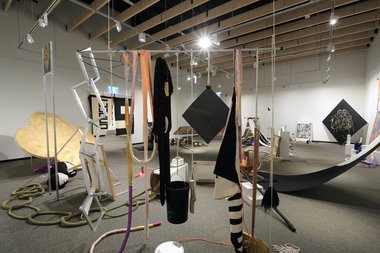


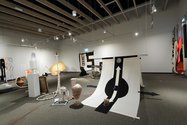
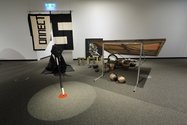
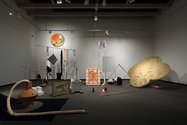

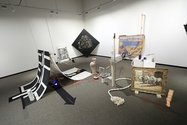

 Advertising in this column
Advertising in this column Two Rooms presents a program of residencies and projects
Two Rooms presents a program of residencies and projects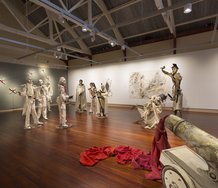

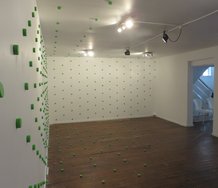
This Discussion has 0 comments.
Comment
Participate
Register to Participate.
Sign in
Sign in to an existing account.